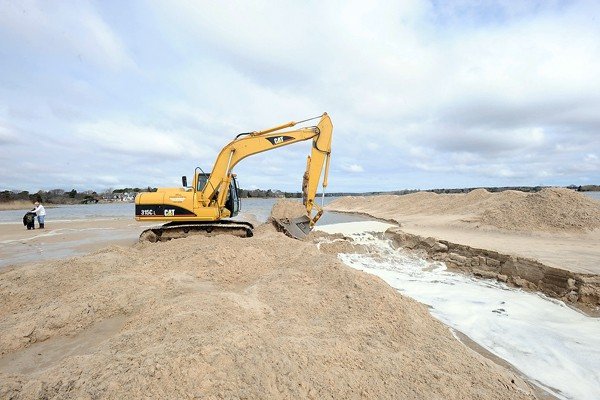
The East Hampton Town Trustees have been granted a permit by the State Department of Environmental Conservation to resume removing sand from the floodplain of the Georgica Pond cut.
The removal of the sand, the Trustees have said, helps with the flow of water out of and back into the pond when the cut is dug open each spring and fall, improving water quality. The Trustees also sell the sand to shoreline contractors who use it to bolster dunes along the oceanfront.
It has been five years since the last state permit expired and two years since the Trustees, in a change of longstanding policy, began negotiating for the new permit themselves.
The Trustees have historically avoided direct intra-agency discussions with the DEC because they see their colonial-era charter as superseding that of the state’s authority when it comes to matters in their jurisdiction and have been wary about recognizing the state’s regulatory powers. The East Hampton Town Natural Resources Department applied for and held the last state-issued permit for the dredging, even though it took place on Trustees-owned ground.
The new permit does not address the Trustees’ traditional opening of the cut each spring and fall, which the board does without any input from the DEC. Trustees Clerk Francis Bock said that the DEC had tried to include the seasonal openings in the permit but the Trustees rejected it.
“We responded to them and highlighted the parts we objected to and we hammered it out,” Mr. Bock said.
Nonetheless, the Trustees acknowledged the reasons the DEC sees the dredging as something that needs additional checks beyond the Trustees.
“The DEC wants to be involved with this because the Trustees sell the sand and they want to make sure this is about improving water quality in the pond, not a sand mining operation,” Trustee Bill Taylor said. “This will let us shape the opening of the cut so that it facilitates a more efficient opening of the pond.”
Mr. Bock said that the Trustees will use some of the sand to fix a problem spot in the pond shoreline created by past sand mining of the floodplain, which may have led to extensive erosion of dunes in front of the Georgica Association’s beach pavilion.
Mr. Bock said that about 10 percent of the sand removed from the pond over the next several years will be used to replenish the dune area by the association’s pavilion and that the DEC permits laid out very specific parameters for where the sand may be mined from to ensure that the openings of the cut don’t “threaten” neighboring properties.
The new permit will allow the Trustees to remove up to 15,000 cubic yards of sand—enough to fill about 1,500 dump trucks—each year for the next 10 years. The last time the Trustees contracted for the sale of the sand—which is dredged by the contractors using it to rebuild dunes at private residences—the rate was $7.50 per cubic yard, Mr. Taylor said.
The dredging will have to be completed by March 31 and the Trustees hope to be able to get the sand removal under way this winter. The state permits are still subject to a waiting period to allow input from the U.S. Army Corps of Engineers, so the exact timing of when the dredging could begin is not known yet.
In addition to dredging the floodplain, the Trustees have also applied for a permit to dredge the narrow channel neck that runs between the main body of the pond and the Georgica Cove tributary. The neck has become clogged with phragmites and silting, nearly stanching the flow of water into the cove, exacerbating chronic water quality problems in the pond.